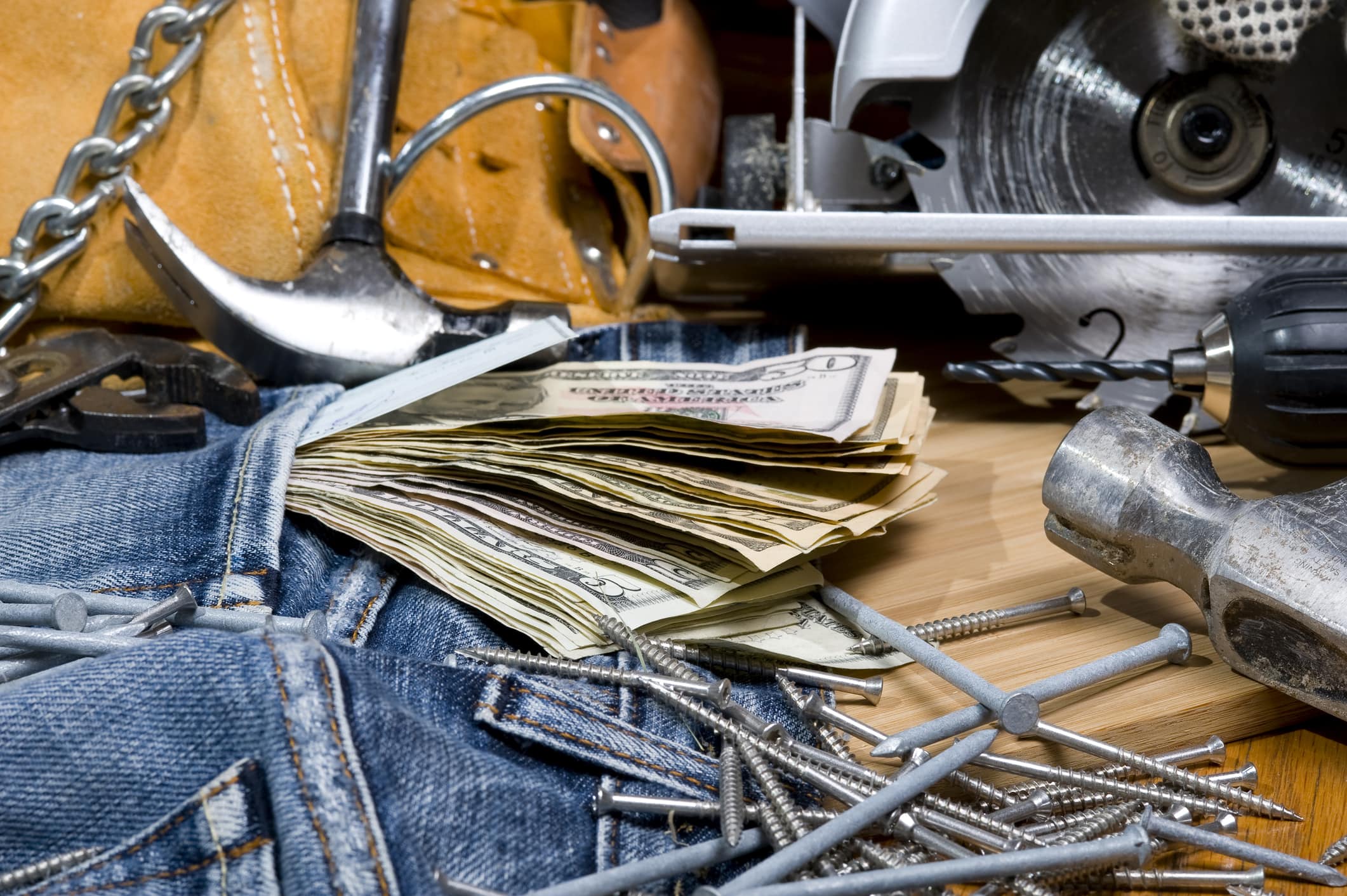Are you considering breaking out your toolbox and taking your handyman talents to the next level by starting a full-fledged business? Before you jump in, you first need to know how much a handyman makes. According to our survey of 1,000 small business owners, handymen and contractors made between $25,000 to $75,000 in 2021.
These numbers are slightly higher than those provided by the United States Bureau of Labor Statistics (BLS). However, the BLS does not include salary estimates for self-employed handypeople.1
Average Handyman Salary2
| Low | Median | High |
|---|---|---|
| $28,910 | $43,180 | $62,400 |
Let’s drill into the latest salary figures for handypeople and share tips for boosting your salary in 2022.
How much do handymen make per day?
According to the BLS, there are over 1.4 million handymen and repair workers in the United States. The average pay for the job is $44,920 per year, which translates to $21.60 per hour – or $172.80 per day for eight hours of work. The top 10% of handymen earn more than $62,400 annually.3
Where do handypersons make the most money?
The three states with the highest average salaries for handypersons are:
- Alaska: $53,370 per year
- Massachusetts: $51,930 per year
- Hawaii: $51,710 per year
The top-paying metropolitan areas include California’s Bay Area, at around $60,000 per year; Maui, Hawaii, at $56,650 per year; and the Seattle, Washington area, at $54,120 per year.4
How much revenue can handypeople make?
The revenue that handypeople can make varies. Just under half of the handypeople we surveyed reported annual gross revenue up to $50,000. However, one in five reported gross yearly revenue between $50,000 and $100,000, and nearly 30% reported annual gross revenues between $100,000 and $500,000. And 5% reported annual gross revenues even higher than $500,000.
The majority (71%) felt optimistic heading into 2022, expecting their revenue to increase this year. Among those, nearly half expect revenue increases of around 10%, while the other half expect revenue increases between 25% to 50%.
What do handymen do?
Handypeople perform general repairs for homes and businesses. They may install shelves or flooring, mount televisions, clean gutters, and touch up paint. Typically, one person can perform the work and does not require special machinery or handyman licensing.
Many of the handymen we surveyed enjoy the independence of being their own boss and getting to set their rates and schedule. One told us, “I enjoy the variety, freedom, and challenge of running a business. Having a 9-5 would not be fulfilling for me.” They also enjoy the security the industry affords them. As one handyman said, “People need things fixed around [their] house all the time.”
How to increase your salary as a handyperson
One of the great things about being your own boss is setting your own salary. As one handyman told us, “I think my time is more valuable than the workforce tries to tell me how much I am worth an hour.” If you’re looking to increase your handyman salary in 2022, here are some strategies.
- Cater to higher-paying clientele – For example, handypeople who work for schools net over $46,000 per year, on average. In contrast, those working in real estate or the hotel industry earn $41,920 or $38,890 per year, respectively.5 Try switching up your clientele this year.
- Get trained and licensed – Offering additional, higher-level services such as carpentry, electrical repair, or plumbing can allow you to charge higher rates and serve more clients. Consider getting licensed in other specialties to increase your salary.
- Hire people to work for you – Part of the joy of running your own business is the ability to grow it. “I love the freedom and expansion opportunities of owning my own business,” one handyman told us. And, the more revenue a business reported, the more likely they were to have crews of 1 or more additional handypersons working for them.
One of the best ways to increase your salary is to find your niche before you start your handyperson business. Because the job is so popular, differentiating your services can skyrocket your potential.
How much does it cost to run a handyman business?
There are some costs to running a handyman business. When developing your business budget, be sure to factor in the following.
- Equipment – As a handyman, you’ve got to have all the tools of the trade. Fill out your toolbelt with drills, hammers, screwdrivers, wrenches, utility knives, and tape measures.
- Transportation – Many handymen choose to invest in a truck, which affords them more room than the trunk of a car to carry around their tools and toolboxes. Brand your vehicle with your name and contact information, so your clients’ neighbors can easily hire you.
- Marketing – Word of mouth can only get you so far. Savvy handypeople make an effort to market themselves. Get listed on websites like Yelp, Thumbtack, and HomeAdvisor. Generate positive reviews on Google. Connect with other home professionals like realtors and general contractors who can send more work your way. Make sure that people can find you on local search engines.
- Business insurance – Insurance is necessary for every business owner, especially handymen. Handyman Insurance is a customizable package of coverages tailored for your business.
Repair your salary
Handypeople can earn a decent living, on their terms and on their schedule. To maximize your earning potential this year, consider increasing your training and expertise, marketing yourself to different clients, and growing your team.
Perhaps more than anyone else, handymen know that things can go sideways. One handyman in our survey said, “We fix the broken things in people’s homes.” That’s why you need Handyman Insurance from Thimble. Protect your business by the job, month, or year with coverage that works when you do. We’re not high maintenance. Whether you’re doing an odd job or contracted for a long-term gig, get your policy in minutes.
Sources:
- U.S. Bureau of Labor Statistics. Maintenance and Repair Workers, General.
- U.S. Bureau of Labor Statistics. Maintenance and Repair Workers, General.
- U.S. Bureau of Labor Statistics. Maintenance and Repair Workers, General.
- U.S. Bureau of Labor Statistics. Maintenance and Repair Workers, General.
- U.S. Bureau of Labor Statistics. Maintenance and Repair Workers, General.








